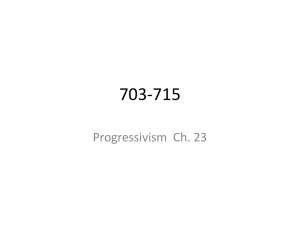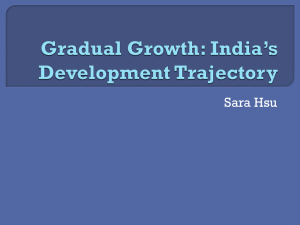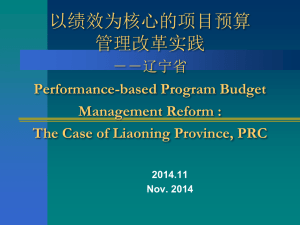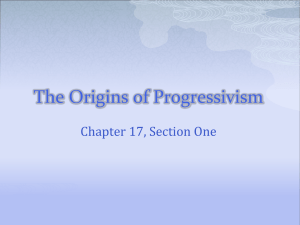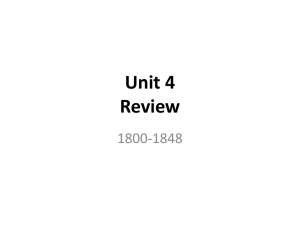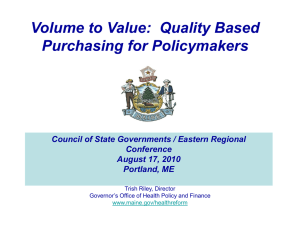Slides - Department of Economics
advertisement
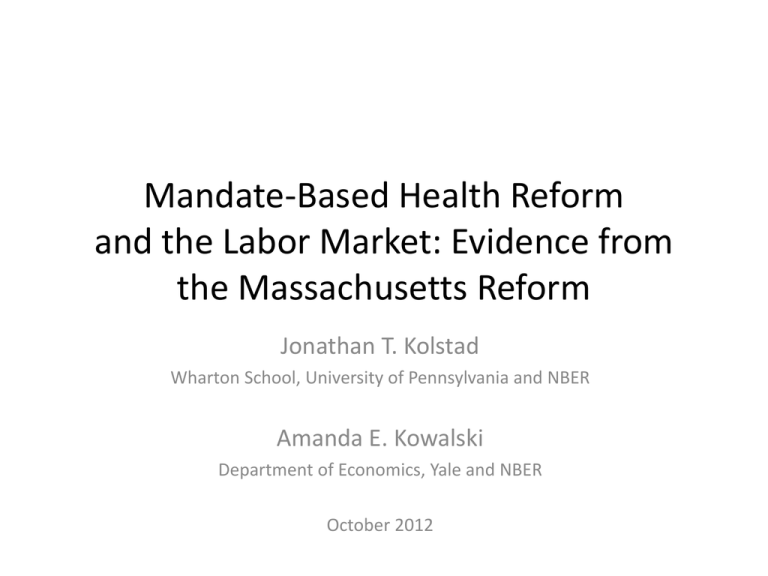
Mandate-Based Health Reform
and the Labor Market: Evidence from
the Massachusetts Reform
Jonathan T. Kolstad
Wharton School, University of Pennsylvania and NBER
Amanda E. Kowalski
Department of Economics, Yale and NBER
October 2012
ACA and the Massachusetts Reform are
Mandate-Based Health Reforms
• ACA is biggest change to health policy since
introduction of Medicare and Medicaid in 1965
• 3 Key elements of “Mandate-Based Reform”
1. Mandate that employers must offer coverage or
pay a penalty
2. Mandate that individuals must have coverage or
pay a penalty
3. Expansions in publicly-subsidized coverage
outside of employment
Mandate-based reforms depend critically on
relationship between ESHI and the labor market
• Vast majority of nonelderly have employersponsored health insurance (ESHI)
– CBO predicts 7-8 million newly insured through employersponsored health insurance by 2019
We build and estimate a model of mandatebased reform and the labor market
• Develop a simple model of mandate-based health
reform
1. Characterize compensating differential for ESHI
2. Characterize the welfare impact of mandate-based
reform relative to tax-based reform in terms of key
“sufficient statistics,” which depend on the
compensating differential
• Rely on the Massachusetts reform to estimate the
empirical analog of our theoretical model
1. Estimate the compensating differential for ESHI
2. Estimate the welfare impact of mandate-based reform
relative to counterfactual tax-based reform
Our model extends existing theory of
ESHI and the labor market
• Our model extends Summers (1989)
– Adds empirical content, allowing us to recover all
model parameters
• Cost of ESHI to employers, underlying valuation of ESHI, labor
supply and demand elasticities, behavioral responses to
individual and employer mandates and subsidies
– Demonstrates value of capturing policy
interactions
• Employer mandate increases distortion if individual mandate
already in place
Our findings contribute to empirical lit.
on ESHI and the labor market
1. We find a compensating differential for ESHI of the expected
theoretical sign and a magnitude ≈ cost of providing ESHI
– Most estimates of compensating differential from literature are
wrong-signed (workers with ESHI also have higher wages)
– Estimates of expected theoretical sign rely on incremental changes in
cost of ESHI
•
•
Gruber 1994: mandated maternity benefits
Baicker and Chandra (2005): increasing malpractice costs
– Our estimate of the compensating differential reflects the full cost of
ESHI to employers
2. We translate our compensating differential into key
sufficient statistics for welfare analysis
–
Mandate-based reform is substantially more efficient than
alternative tax-based reform: 2% of DWL
Key Question for Supreme Court:
Is the individual mandate penalty a tax?
JUSTICE ALITO:
General Verrilli, today
you are arguing that
the penalty is not a
tax. Tomorrow you are
going to be back and
you will be arguing
that the penalty is a
tax.
We inform the economics of a
mandate penalty vs. a tax
Outline
I.
II.
III.
IV.
V.
Massachusetts Reform and the ACA
Model of Mandate-Based Health Reform
Identification and Estimation
Results
Robustness and Implications for National
Reform
VI. Conclusion
Much Discussion with Little
(but growing) Evidence
Evidence on the
labor market?
Massachusetts Reform,
A Model for National Reform
• “…the fact of the matter is, we
used the same advisers, and
they say it’s the same plan.”
-President Obama,
First Presidential Debate 2012
Key Provisions of Massachusetts and National
Health Reform
Massachusetts Reform, April 2006
• Individual mandate
– Penalty is up to 50% of basic plan by
months without coverage
• Employers mandated to offer
coverage
– >10 FTEs
– Penalty is $295/worker
• Medicaid expansions
– Up to 100% of FPL for adults
• Subsidized private plans through
exchanges
– Subsidies up to 300% of FPL
Reference: Kaiser Family Foundation
Key Provisions of Massachusetts and National
Health Reform
Massachusetts Reform, April 2006
• Individual mandate
– Penalty is up to 50% of basic plan by
months without coverage
National Reform, March 2010
• Individual mandate
– Penalty is higher of 2.5% of income or
$2,085
•
• Employers mandated to offer
coverage
– >50 FTEs
– Penalty is $2,000 per FTE for not offering
any insurance
– Penalty is $3,000 per FTE for not offering
affordable coverage, for all employees
receiving tax credit (not assessed on first
30 employees)
– >10 FTEs
– Penalty is $295/worker
• Medicaid expansions
– Up to 100% of FPL for adults
• Subsidized private plans through
exchanges
– Subsidies up to 300% of FPL
Reference: Kaiser Family Foundation
Employers mandated to offer
coverage
•
Medicaid expansions
– Up to 133% of FPL
•
Subsidized private plans through
exchanges
– Subsidies up to 400% of FPL
Impact on Nonelderly Coverage
Diff-in-Diff Coverage Impact from CPS
• Significant decline in unisurance
• 49% reduction relative to MA pre-reform
• Magnitude of increase after reform was similar for ESHI and
Medicaid coverage
A Model of the Labor Market with
Mandate-Based Health Reform
• Alternate approaches to evaluation of policy options for health reform:
Reduced form evaluation of health insurance
expansion:
• Identify a policy experiment (e.g.
Massachusetts)
• See what happened to aggregate labor
market outcomes and coverage rates
• Requires fewer assumptions and gives clear
identification of parameters
Structural model of demand for health
insurance, wages and employment:
• Model individual’s distributions of health care
risk, risk aversion parameters, beliefs about
risk, marginal tax rate
• Estimate why individual does not have
coverage and how willing individual would be
to gain coverage
• Relate to model of labor market outcomes
• Develop a simple model that nests the full range of structural parameters
in “sufficient statistics” that can be measured in labor market outcomes
– Build on the intuition of Summers (1989) and Gruber and Krueger (1991)
– Can express policy parameters in the same framework extend to a general
model of mandate-based policy and the labor market
– Use key, observable parameters in the spirit of Chetty (2009)
The Model
• Build on the basic framework of Summers (1989) and Gruber
and Krueger (1991)
• Key features of the model and mandate-based health reform
–
–
–
–
–
Cost of a standardized health benefit: b
Individual’s valuation of the benefit: 0
Individual penalty for non-compliance (individual mandate): t ( 0 ,1)
Employer penalty for non-compliance (employer mandate): t ( 0 ,1)
Subsidy level: xt ( 0 ,1)
• Labor market equilibrium:
– Labor supply:
LS LS
t
ESHI , t
( w b t b xt b ) ESHI
LS
NoESHI , t
t
( w )( 1 ESHI t )
– Labor demand:
LD LD
t
ESHI , t
( w b ) ESHI
LD
NoESHI , t
t
( w t b )( 1 ESHI t )
Key Provisions of Massachusetts and National
Health Reform
Massachusetts Reform, April 2006
• Individual mandate
– Penalty is up to 50% of basic plan by
months without coverage
• Employers mandated to offer
coverage
– >10 FTEs
• Medicaid expansions
– Up to 100% of FPL for adults
• Subsidized private plans through
exchanges
– Subsidies up to 300% of FPL
Reference: Kaiser Family Foundation
National Reform, March 2010
• Individual mandate
– Penalty is higher of 2.5% of income or
$2,085
• Employers mandated to offer
coverage
– >50 FTEs
• Medicaid expansions
– Up to 133% of FPL
• Subsidized private plans through
exchanges
– Subsidies up to 400% of FPL
Key Provisions of Massachusetts and National
Health Reform
Massachusetts Reform, April 2006
• Individual mandate
– Penalty is up to 50% of basic plan by
months without coverage
• Employers mandated to offer
coverage
– >10 FTEs
• Medicaid expansions
– Up to 100% of FPL for adults
• Subsidized private plans through
exchanges
– Subsidies up to 300% of FPL
Reference: Kaiser Family Foundation
National Reform, March 2010
• Individual mandate
– Penalty is higher of 2.5% of income or
$2,085
• Employers mandated to offer
coverage
– >50 FTEs
• Medicaid expansions
– Up to 133% of FPL
• Subsidized private plans through
exchanges
– Subsidies up to 400% of FPL
Key Provisions of Massachusetts and National
Health Reform
Massachusetts Reform, April 2006
• Individual mandate
– Penalty is up to 50% of basic plan by
months without coverage
• Employers mandated to offer
coverage
– >10 FTEs
• Medicaid expansions
– Up to 100% of FPL for adults
• Subsidized private plans through
x
exchanges
– Subsidies up to 300% of FPL
Reference: Kaiser Family Foundation
National Reform, March 2010
• Individual mandate
– Penalty is higher of 2.5% of income or
$2,085
• Employers mandated to offer
coverage
– >50 FTEs
• Medicaid expansions
– Up to 133% of FPL
• Subsidized private plans through
exchanges
– Subsidies up to 400% of FPL
We can use the model to characterize
1. Compensating differential for ESHI
(1 t ) s ( t xt )
d s
b
• Hours differential for ESHI
1 t ( t xt )
d s
b
2. Sufficient statistics for welfare impact of
mandate-based reform
DWL
m
b
2
(1 ( After x , After )) ESHI
2
s(s d )
After
2
After
(1 ESHI
After
• Welfare impact relative to tax-based reform
DWL
DWL
m
b
2
2
(1 ( After x , After )) ESHI
2
After
2
After
(1 ESHI
After
)
)
Graphical Representation
• Allows us to visualize the compensating and
hours differentials for ESHI and the welfare
impact of mandate-based reform relative to taxbased reform
• We build up the graphical representation with
one policy at a time
–
–
–
–
Tax
Employer Mandate (full-compliance, pay-or-play)
Individual Mandate (pay-or-play)
Subsidies
Graphical Model – No Employer-Sponsored Health Ins (ESHI)
w
w NoESHI
, Before
NoESHI , Before
LS
A
NoESHI , Before
LD
L
L NoESHI
, Before
Employer Tax to Finance Health Insurance
w
w NoESHI
T’
NoESHI , t
LS
A
, Before
w NoESHI
T
NoESHI , Before
LD
, After
b
NoESHI , After
LD
L NoESHI
, After
L NoESHI
, Before
L
Employer Tax to Finance Health Insurance
w
w NoESHI
T’
NoESHI , t
LS
A
, Before
w NoESHI
DWL: TAT’
T
NoESHI , Before
LD
, After
b
NoESHI , After
LD
L NoESHI
, After
L NoESHI
, Before
L
Full-Compliance Employer Mandate
Summers (1989)
w
T’
LS
D’
w NoESHI
A
,t
DWL if ESHI,After=1: D’’AD’
DWL if ESHI,After=0: not possible
Employer mandate
NoESHI , t
decreases DWL!
ESHI , t
b
LS
D’’
T
w ESHI
,t
NoESHI , t
LD
D
b
ESHI , t
LD
L ESHI
,t
L NoESHI
,t
L
Pay-or-Play Employer Mandate
w
T’
NoESHI , t
D’
w NoESHI
w NoESHI
DWL if ESHI,After=1: D’’AD’
DWL if ESHI,After=0: BAB’
LS
B’
A
, Before
b
ESHI , Before
LS
B
, After
D’’
T
w ESHI
,t
b LNoESHI
D
D
NoESHI , After
LD
b
ESHI , t
LD
L ESHI , t
L NoESHI
, After
L NoESHI
, Before
L
, Before
Pay-or-Play Individual Mandate Only
w
T’
NoESHI , t
LS
D’
w NoESHI
DWL if ESHI,After=1: F’’AF’
DWL if ESHI,After=0: 0
F’ A
F’’
,t
ESHI , Before
b
LS
( x )b
ESHI , After
LS
D’’
T
w ESHI
NoESHI , Before
LD
D
, Before
F
w ESHI , After
b
ESHI , t
LD
L ESHI
, Before
L ESHI
, After
L NoESHI
,t
L
Pay-or-Play Employer Mandate
And Pay-or-Play Individual Mandate
w
DWL if ESHI,After=1: F’’AF’
DWL if ESHI,After=0: BAB’
Employer mandate
NoESHI , t
increases DWL!
T’
LS
D’
w NoESHI
B’
, Before
w NoESHI
F’ A
F’’
b
ESHI , Before
LS
( x )b
ESHI , After
B
, After
LS
D’’
T
w ESHI
b LNoESHI
D
D
, Before
F
w ESHI , After
NoESHI , After
LD
b
ESHI , t
LD
L ESHI
, Before
L ESHI
L NoESHI
, After
, After
L NoESHI
, Before
L
, Before
Key to Identification:
Differences Between Labor Market Equilibria
• Express compensating and hours in terms of wages
(w) and hours (L)
– Preferred compensating differential:
– Preferred hours differential:
𝑤𝐹 − 𝑤𝐴
𝐿𝐹 − 𝐿𝐴
• Express all sufficient statistics in terms of wages (w)
and hours (L)
– Cost of ESHI to employers
𝑏 = 𝑑 𝐿𝐹 − 𝐿𝐴 − 𝑤𝐹 − 𝑤𝐴
– Penalty-and-subsidy-inclusive valuation of ESHI
x
s ( LF L A ) ( w F w A )
b
Compensating Differential
w
T’
NoESHI , t
LS
D’
w NoESHI
B’
, Before
w NoESHI
F’ A
F’’
b
ESHI , Before
LS
( x )b
ESHI , After
B
, After
LS
D’’
T
w ESHI
b LNoESHI
D
D
, Before
F
w ESHI , After
NoESHI , After
LD
b
ESHI , t
LD
L ESHI
, Before
L ESHI
L NoESHI
, After
, After
L NoESHI
, Before
L
, Before
Hours Differential
w
T’
NoESHI , t
LS
D’
w NoESHI
B’
, Before
w NoESHI
F’ A
F’’
b
ESHI , Before
LS
( x )b
ESHI , After
B
, After
LS
D’’
T
w ESHI
b LNoESHI
D
D
, Before
F
w ESHI , After
NoESHI , After
LD
b
ESHI , t
LD
L ESHI
, Before
L ESHI
L NoESHI
, After
, After
L NoESHI
, Before
L
, Before
Cost of ESHI to Employers b
DWL of tax-based reform proportional to b2
w
T’
NoESHI , t
LS
D’
w NoESHI
B’
, Before
w NoESHI
F’ A
F’’
b
ESHI , Before
LS
( x )b
ESHI , After
B
, After
LS
D’’
T
w ESHI
b LNoESHI
D
D
, Before
F
w ESHI , After
NoESHI , After
LD
b
ESHI , t
LD
L ESHI
, Before
L ESHI
L NoESHI
, After
, After
L NoESHI
, Before
L
, Before
Cost of ESHI to Employers b
DWL of mandate-based reform for ESHI,After=1 proportional to (1-(α+λ-µx))2
w
T’
NoESHI , t
LS
D’
w NoESHI
B’
, Before
w NoESHI
F’ A
F’’
b
ESHI , Before
LS
( x )b
ESHI , After
B
, After
LS
D’’
T
w ESHI
b LNoESHI
D
D
, Before
F
w ESHI , After
NoESHI , After
LD
b
ESHI , t
LD
L ESHI
, Before
L ESHI
L NoESHI
, After
, After
L NoESHI
, Before
L
, Before
All Sufficient Statistics are
Differences Between Labor Market
Equilibria
Taking the Model to MA
• Minimum needed for identification
– 8 data points from within MA
• ESHI, NoESHI and After,Before for w,L
• Add more variation to identify parameters more
convincingly
– MA vs. Non-MA
– Within individual over time
– Small (exempt) firms vs. large firms – preferred
specification
• Add more variation to identify more parameters
– Different subsidy amounts based on eligibility
• Separately identify individual penalty from subsidy
• Separately identify behavioral responses to different subsidy
amounts for different eligibility categories
Estimation
Wage and Hours Equations
Estimate separate equations for w and L
• Baseline – no firm size interactions (bracketed)
• Preferred – firm size interactions
Sufficient Statistics
In Terms of Coefficients
Data
• Survey of Income and Program Participation
(SIPP)
– Longitudinal data from January 2004-December 2007
• 2004: 72,057 unique individuals, 2,047 in MA
• 2007: 28,661 unique individuals, 685 in MA
– Includes health insurance coverage
– Issues of seam bias and alternate panel weights
• Also examine restricted-use MEPS, but don’t have
enough sample size (only 15% size of SIPP)
Oct-Dec 03
Jan-Feb 04
Mar-Apr 04
May-Jun 04
July-Aug 04
Sep-Oct 04
Nov-Dec 04
Jan-Feb 05
Mar-Apr 05
May-Jun 05
July-Aug 05
Sep-Oct 05
Nov-Dec 05
Jan-Feb 06
Mar-Apr 06
May-Jun 06
July-Aug 06
Sep-Oct 06
Nov-Dec 06
Jan-Feb 07
Mar-Apr 07
May-Jun 07
July-Aug 07
Sep-Oct 07
Nov-Dec 07
Log Wage Premium for ESHI vs. No ESHI
MA*ESHI
ESHI
0.2
0.15
0.1
0.05
0
-0.05
-0.1
-0.15
-0.2
-0.25
-0.3
Regression coefficients with w as dependent variable. See text for details.
Wages and ESHI are two-month indicators. May-June 2006 are normalized to zero.
Oct-Dec 03
Jan-Feb 04
Mar-Apr 04
May-Jun 04
July-Aug 04
Sep-Oct 04
Nov-Dec 04
Jan-Feb 05
Mar-Apr 05
May-Jun 05
July-Aug 05
Sep-Oct 05
Nov-Dec 05
Jan-Feb 06
Mar-Apr 06
May-Jun 06
July-Aug 06
Sep-Oct 06
Nov-Dec 06
Jan-Feb 07
Mar-Apr 07
May-Jun 07
July-Aug 07
Sep-Oct 07
Nov-Dec 07
Wage Premium for ESHI vs. No ESHI
MA*ESHI
ESHI
3
2
1
0
-1
-2
-3
Regression coefficients with w as dependent variable. See text for details.
Wages and ESHI are two-month indicators. May-June 2006 are normalized to zero.
Preliminary Evidence on the
Compensating Differential
• Figure assumes no employer penalty (~ 0 because ρ small),
therefore, NoESHI, After is an additional control group
– Recall that model predicts that ESHI wages will fall (individual penaltyand-inclusive valuation) AND NoESHI wages will fall (employer penalty)
in MA after reform
• Figure shows ESHI wages lower than NoESHI wages by
approximately 10% or $2.13/hour ($4,435 annually for fulltime)
• KFF Survey from 2007 suggests average premium of $4,355
and $11,770 for individual and families, respectively
– Weighting by family structure and employer share in the SIPP gives
$6,105 on average
• First evidence for relatively high valuations of ESHI among
those impacted by reform
Recall Theoretical Graph
w
T’
NoESHI , t
LS
D’
w NoESHI
B’
, Before
w NoESHI
F’ A
F’’
b
ESHI , Before
LS
( x )b
ESHI , After
B
, After
LS
D’’
T
w ESHI
b LNoESHI
D
D
, Before
F
w ESHI , After
NoESHI , After
LD
b
ESHI , t
LD
L ESHI
, Before
L ESHI
L NoESHI
, After
, After
L NoESHI
, Before
L
, Before
Graphical Depiction of Preferred Estimates
w
3
T’
2
D
F''
-8
-6
-4
-2
F'
1
B' A
Bρ 0
-1
T
-2
FB
LSNoESHI,t
ρb
2
4
L
LDNoESHI,Before
LDNoESHI,After
(α+λ-µ)b L ESHI,After
S
-3
-4
LDESHI,After
Estimated
Compensating and Hours Differentials
Annualized compensating differential: -2.572x40x52=-5,350
Substantial fraction of $6,105 from KFF – valuation will be
high
05, 2.626]
.454**
95, 1.183]
.878**
08, 0.378]
351***
30, 3.031]
.059**
61, 1.914]
.026**
98, 2.242]
[1.940, 3.192]
-0.551**
[-1.380, 0.263]
-0.209**
[-0.658, 0.288]
0.661***
[0.169, 1.014]
0.901***
[0.338, 1.563]
0.586***
[0.136, 1.139]
[0.631, 1.001]
0.740
1.000
-
Estimated Sufficient Statistics
And Welfare Impact of Health Reform
0.150***
[0.007, 1.076]
0.021***
[0.002, 0.101]
79,423
460,630
Penalty-and-subsidy-inclusive
0.753
0.836
valuation:
nce intervals reported; CIs block bootstrapped
by state. 84%
Monthly weights used.
Annualized cost of ESHI b: $6,007
Annualized DWLm: $8 per year per
full-time worker, 2% DWLτ
Robustness to Calibrated Values
• Compensating and hours differentials do not reflect
calibrated values
– 95% CI for compensating differential (-$7,956, -$3,122)
• Efficiency of mandate-based relative to tax-based
health reform (DWL ratio = 2%) reflects calibration
– 95% CI for DWL ratio (0.2% to 10.1%) is smaller than actual
– Increase employer penalty ρ from $295 (4.9% of b) to
25% of b, DWL ratio = 7%
– Increase b/τ from 1 to 1.1, DWL ratio = 6.5%, increase b/τ to
1.5 (gov. has 50% loading), DWL ratio = 12%
– Increase supply elasticity from 0.1 to .2, DWL ratio=9.5%
– Decrease demand elast. from -0.2 to -0.4, DWL ratio=10.6%
Robustness to Estimation Sample
• Allow underlying valuation α to vary across
individuals
– Can examine incidence across employee groups in
model with heterogeneity
– Test of robustness in true model
• Restrict estimation sample to different groups
– New England only
• Larger compensating and hours differentials, penaltyand-subsidy-inclusive valuation: 0.77, DWL ratio: 3.8%
– Married people only (different valuation?)
• Penalty-and-subsidy-inclusive valuation: 0.71
Robustness to Intensive Margin Only
• Fixed cost of ESHI may favor hours margin over
employment margin (Cutler and Madrian, 1998)
– Baseline specification allows for an effect on both
• Restrict sample only to workers
1. Paid job & w>0 in given period
2. Paid job & w>0 in entire SIPP
3. Paid job & w>0 & same job in entire SIPP
•
•
Can estimate levels and logs specifications
Still observe compensating differential in all
specifications, DWL ratio from 4.6% to 18.4%
Suggests that extensive margin decision of whether to
work and job switches do not drive our results
Implications for National Reform
• ACA has higher employer penalty ρ
– Penalty of $3,000/employee (46% of b) increases
DWL ratio to 10.8%
• ACA has higher individual penalty λ
– Decreases distortion relative to MA
• ACA has smaller subsidies
– Decreases distortion relative to MA
• ACA extends subsidies to more people
– Increases distortion relative to MA
Conclusion I: We extend existing
theory of ESHI and the labor market
• Our model extends Summers (1989)
– Adds empirical content, allowing us to recover all
model parameters
• Cost of ESHI to employers, underlying valuation of ESHI, labor
supply and demand elasticities, behavioral responses to
individual and employer mandates and subsidies
– Demonstrates value of capturing policy
interactions
• Employer mandate increases distortion if individual mandate
already in place
Conclusion II: We find compensating
differential for full cost of ESHI
• We find a compensating differential for ESHI of the
expected theoretical sign and a magnitude ≈ cost of
providing ESHI
– Most estimates of compensating differential from
literature are wrong-signed (workers with ESHI also have
higher wages)
– Estimates of expected theoretical sign rely on incremental
changes in cost of ESHI
•
•
Gruber 1994: mandated maternity benefits
Baicker and Chandra (2005): increasing malpractice costs
– Our estimate of the compensating differential reflects the
full cost of ESHI to employers
Conclusion III: We find DWL lower under
mandate-based reform relative to taxbased reform
• We translate
our compensating differential
into key sufficient statistics for welfare analysis
– Mandate-based reform is substantially more
efficient than alternative tax-based reform: 2%
of DWL
– This result is robust
Broader Research Agenda on
Massachusetts & National Reforms
• Hospital and preventive care (JPubEc, 2012)
• Testing for adverse selection (AER P&P, May
2012)
• Welfare cost of adverse selection (coming soon)
• Risk-protective benefits of health insurance
• Separating risk type from risk preference
Extra Slides
Pay-or-Play Employer Mandate
And Pay-or-Play Individual Mandate And Subsidy
T’
w
C’D’
NoESHI , t , x
LS
B’
B
E’ F’
D
ESHI , t , III
LS
ESHI , After , II
LS
b
ESHI , Before ,{ I , II }
LS
b
ESHI , After , I
LS
III b
C’’
C
A
F’’
E’’
D’’
T
DWL if ESHI,After=1: E’’AE’
DWL if ESHI,After=0: BAB’
E F
b LNoESHI
D
II b
, Before , x
NoESHI , After , x
LD
b
L
NoESHI , t , x
D
L
Summary Statistics
Full Population
MA
Non-MA
MA-Non-MA
Before
After
Before
After
Before
After
After-Before
w: Weekly earnings / baseline hours per week
14.45
15.11
18.56
20.62
14.36
14.99
1.443***
w|paid job & w>0
20.75
22.36
25.36
26.94
20.64
22.24
0.140
Log(w|paid job & w>0)
2.77
2.84
2.96
3.03
2.76
2.83
0.001
L: Hours per week
29.23
28.80
30.19
31.05
29.21
28.75
1.196***
L|paid job & L>0
39.05
38.85
38.27
37.82
39.07
38.87
-0.285***
Log(L|paid job & L>0)
3.61
3.61
3.57
3.56
3.61
3.61
-0.004
Hours per week in all jobs
41.24
40.93
40.63
39.48
41.25
40.97
-0.990***
Paid job
0.78
0.78
0.82
0.84
0.78
0.78
0.030***
Employed by Large Firm|paid job
0.85
0.84
0.86
0.82
0.85
0.85
-0.021***
Any Health Insurance
0.83
0.84
0.90
0.95
0.83
0.83
0.036***
ESHI
0.66
0.65
0.74
0.74
0.65
0.65
0.013***
<150%FPL†
0.13
0.11
0.09
0.08
0.13
0.11
0.003
150-300%FPL†
0.19
0.16
0.14
0.09
0.19
0.16
-0.011***
Age
40.01
40.27
40.50
40.79
40.00
40.25
0.026
Married
0.56
0.55
0.54
0.50
0.56
0.55
-0.028***
Female
0.51
0.51
0.51
0.52
0.51
0.51
0.000
†FPL category defined for each individual based on status in the Jan-June 2006 period.
2004 SIPP Panel. Monthly weights used.
Full 18-64 population. Only includes interview months.
Before: October 2003 - June 2006; After: July 2007 - December 2007. Statistics are averages over the relevant period.
MA-Non-MA After-Before is the coefficient on MA*After from a regression of the outcome on MA*After, MA, and After.
***p<0.01, **p<0.05, *p<0.1, block bootstrapped by state.
w and L measures include individuals without a paid job with w=0 or L=0, respectively, unless noted otherwise.
•
•
•
•
3.6% of sample gains health insurance relative to non-MA
Model predicts w and L decrease for people who change ESHI status
In aggregate labor market, expect no or small neg. change, but w and L increase
Suggests that we need to control for MA-specific factors after reform
Wage Trends in MA vs. Non-MA
MA, ESHI
MA, no ESHI
Non-MA, ESHI
Non-MA, no ESHI
30
25
20
15
10
5
Oct-07
Jul-07
Apr-07
Jan-07
Oct-06
Jul-06
Apr-06
Jan-06
Oct-05
Jul-05
Apr-05
Jan-05
Oct-04
Jul-04
Apr-04
Jan-04
Oct-03
0
Weekly earnings / baseline hours per week, including without paid job (wage=0).
Full 18-64 population. Monthly weights are used to calculate means.
Log Wage Trends in MA vs. Non-MA
MA, ESHI
MA, no ESHI
Non-MA, ESHI
Non-MA, no ESHI
3.5
3
2.5
2
1.5
1
0.5
Oct-07
Jul-07
Apr-07
Jan-07
Oct-06
Jul-06
Apr-06
Jan-06
Oct-05
Jul-05
Apr-05
Jan-05
Oct-04
Jul-04
Apr-04
Jan-04
Oct-03
0
Log (weekly earnings / baseline hours per week | paid job & weekly earnings > 0).
Full 18-64 population. Monthly weights are used to calculate means.
Compensating and Hours Differentials
In Terms of Coefficients
Sufficient Statistics
In Terms of Coefficients
Express Equilibria
in Terms of Coefficients
Hours in Terms of Coefficients: replace β with γ
Welfare Impact of Health Reform
•Where identification does not come from changes
induced by the MA reform, we calibrate values
Accounting for Relationship Between
Penalty and Valuation
• Simple model adds underlying valuation and penalty in
valuation
• More realistically, higher valuations are associated with lower
impact of the penalty
– People who already have health insurance because they value it are
not impacted by penalty
• Model the statutory penalty flexibly to account for
interaction:
